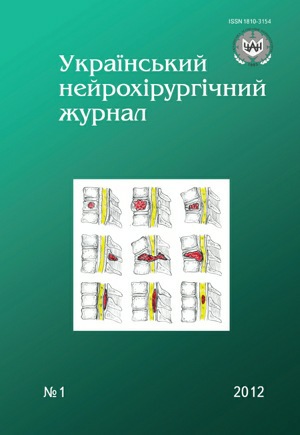Stereotactic radiosurgery for cavernous angioma of the brain
DOI:
https://doi.org/10.25305/unj.57756Keywords:
cavernous angioma of the brain, stereotactic radiosurgeryAbstract
Introduction. As today a debate is taking place about the risk of hemorrhage after radiation treatment of brain cavernous angioma, the results of stereotactic radiosurgery (SRS) for this pathology are presented here.
Methods. SRS with the use of a linear accelerator “Trilogy” and stereotactic system BrainLab were used to treat 28 patients with cavernous angioma of the brain of different localization. The target volume ranged from 0.18 to 11.62 cm3 (mean 2.16 cm3, median 1.18 cm3), the prescribed dose ranged from 12 to 17 Gy (mean 14.5 Gy, median 15 Gy). The SRS target volume, affected by the prescribed dose, was 88-99% (mean 94.5%, median 95%). The maximum dose ranged from 13.8 to 20 Gy (mean 17 Gy, median 17.2 Gy). MRI was applied to 17 patients with intravenous contrasting within a period of 3 to 11 months after treatment.
Results. Improvement in the neurological status was reported in 6 (35.3%) patients. MRI positive dynamics were also observed. 3 (17.6%) patients had neurological deterioration after SRS and MRI negative dynamics. 8 (47.1%) patients exhibited a stable MR picture, 6 of them had no changes in neurological status and 2 showed improvement.
Conclusions. SRS is an effective method of treating brain cavernomas, which is aimed at reducing the risk of hemorrhage and decreasing the seizure frequency.
Optimizing the prescribed dose (12–14 Gy) will help reduce the risk of hemorrhage with large cavernomas. However, for small cavernomas (less than 3 cm3) and a higher dose (15–16 Gy), the risk of complications in the postradiation period is small, but the probability of cavernoma obliteration is higher.
References
1. Raychaudhuri R, Batjer HH, Awad IA. Intracranial cavernous angioma: a practical review of clinical and biological aspects. Surg Neurol. 2005 Apr;63(4):319-28. [CrossRef] [PubMed]
2. Kayali H, Sait S, Serdar K, Kaan O, Ilker S, Erdener T. Intracranial cavernomas: analysis of 37 cases and literature review. Neurol India. 2004 Dec;52(4):439-42. [PubMed]
3. Shalek RA, Vinogradov VM, Garmashov YuA. Vozmozhnosti stereotaksicheskoy luchevoy terapii kavernoznykh angiom golovnogo mozga [Features of stereotactic radiation therapy of cerebral cavernous angiomas]. In: Abstract Book of the VII All Rus. Scientific Forum “Radiology 2006”. Moscow; 2006. p.264-5. Russian.
4. Blamek S, Idasiak A, Larysz D et al. Linac-based Stereotactic Radiosurgery for Brain Cavernomas. Intern J Radiat Oncol Biol Phys. 2010;78(3):S291-S292. [CrossRef]
5. Nagy G, Razak A, Rowe JG, Hodgson TJ, Coley SC, Radatz MW, Patel UJ, Kemeny AA. Stereotactic radiosurgery for deep-seated cavernous malformations: a move toward more active, early intervention. Clinical article. J Neurosurg. 2010 Oct;113(4):691-9. [CrossRef] [PubMed]
6. Lunsford LD, Khan AA, Niranjan A, Kano H, Flickinger JC, Kondziolka D. Stereotactic radiosurgery for symptomatic solitary cerebral cavernous malformations considered high risk for resection. J Neurosurg. 2010 Jul;113(1):23-9. [CrossRef] [PubMed]
7. Hassen-Khodja R. Gamma knife and linear accelerator stereotactic radiosurgery. Montreal: AETMIS; 2004;17.
8. Steiner L, Karlsson B, Yen CP, Torner JC, Lindquist C, Schlesinger D. Radiosurgery in cavernous malformations: anatomy of a controversy. J Neurosurg. 2010 Jul;113(1):16-22. [CrossRef] [PubMed]
9. Hsu PW, Chang CN, Tseng CK, Wei KC, Wang CC, Chuang CC, Huang YC. Treatment of epileptogenic cavernomas: surgery versus radiosurgery. Cerebrovasc Dis. 2007;24(1):116-21. [CrossRef] [PubMed]
Downloads
Published
How to Cite
Issue
Section
License
Copyright (c) 2012 Olga Chuvashova, Irina Kruchok

This work is licensed under a Creative Commons Attribution 4.0 International License.
Ukrainian Neurosurgical Journal abides by the CREATIVE COMMONS copyright rights and permissions for open access journals.
Authors, who are published in this Journal, agree to the following conditions:
1. The authors reserve the right to authorship of the work and pass the first publication right of this work to the Journal under the terms of Creative Commons Attribution License, which allows others to freely distribute the published research with the obligatory reference to the authors of the original work and the first publication of the work in this Journal.
2. The authors have the right to conclude separate supplement agreements that relate to non-exclusive work distribution in the form of which it has been published by the Journal (for example, to upload the work to the online storage of the Journal or publish it as part of a monograph), provided that the reference to the first publication of the work in this Journal is included.









